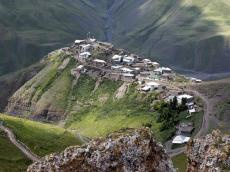|
|
TODAY.AZ / Business
Azerbaijan presents regional map on southern tourist destination
12 January 2021 [10:30] - TODAY.AZ

By Azernews
By Laman Ismayilova
The Azerbaijan State Tourism Agency and the State Tourism Board have presented the Lankaran-Astara regional map within the southern tourism direction.
The map focuses on promoting tourism and ensuring the availability of tourist facilities for visitors, Trend reported.
The regional maps have been previously compiled for the northern and northwestern tourist destinations.
Azerbaijan's south-eastern regions are blessed with fascinating monuments and marvelous nature.
If you visit Azerbaijan, the Land of Fire, you should definitely visit some of them.
Lankaran
The region is home to numerous historical sites .
Lankaran fortress (18th century) and Kichik-Bazar mosque (19th century) deserve special attention. In 100 kilometers north of Lankaran, there is Khanega village of the Middle Ages, where one can find such historical monuments of architecture as the fortress walls (12-14 centuries), the mosque and the tomb of Pir-Hussein, Mirakhmad Khan's Palace and some other ancient buildings.
The subtropical climate of the region is ideal for its growing.The first tea plantations appeared here in 1896. In 1937, the first packs of Azerbaijani tea were released.
Fans of eco-tourism should visit the Gizilagach reserve and the nearby Sarah Peninsula, which are located right at Gizilagach Bay here. Hirkan National Park is another nature reserve placed in Lankaran. It has an enormous territory of 15,000 hectares where animals like wild boars, jackals, Asian leopards can be met.
Zaqatala
Zaqatala has conditions favorable for promoting ecotourism. Visitors can travel on foot and horseback along the tourist trails to observe the different species of animals and birds as well as to take photographs and videos in the reserve.
It is an international region where Azerbaijanis live alongside the people of more than 20 ethnic communities, including the Avars, Lezgins, Tsakhurs, Russians, Tatars, and Ingiloys.
Numerous historical and cultural monuments can be found in the region. Other attractions are the 18th century mosques in Qalal and Gozbarakh villages, the Alban tower dating back to the 12th century, and the 18 century mosque in Mazikh village.
Sheki
Sheki is a unique place set in a picturesque mountain area rich in green valleys, springs, purest rivers, water falls and mineral water springs, dense woods and alpine meadows.
Rightly called the architectural reserve of the country, it is home to multiple historical sites, caravanserais, ancient mosques and much more.
In 2019, historic center of Sheki with the Khans’ Palace was inscribed on UNESCO World Heritage List.
Sheki is also a major center of crafts and has many shops, where, one can buy jewels and engravings by local craftsmen. The city still has street names that indicate the ancient professions – Duluzchular (potters), Zargarlar (jewelers), Halvachylar (confectioners), etc.
Gakh
Gakh region has a long history dating back to ancient times.The area around the village has many historic monuments, including ancient Albanian Christian churches of the 4th-5th centuries. Professional climbers can risk and mount Jinligala's top on the edge of an abyss, which has access only from one side.
The emblem of the village, Sumug fortress, is a four-storey defense tower commanding a great view of the surrounding areas.
Gusar
Gusar is the last large settlement in the north of Azerbaijan and borders the Republic of Dagestan of the Russian Federation.
The highest point of Azerbaijan-Bazarduzu mount, highest cottage in the country – “Suvar” as well as country’s largest carpet are here. The mountain river Gusarchay, in honor of which the city acquired its name, flows in Gusar. There is also an artificial lake, Fialka.
Shahdag Winter and Summer Tourist Complex has gained a high popularity both among Azerbaijanis and foreigners.
Many historical monuments are preserved in Gusar. The historical monuments are protected in the region.
The remains of the fortress walls of the village of Anigof of the 13th century, the mausoleum of Sheikh Juneyd near Hazra village, ancient mosques in villages of Hil, Anig, Balagusar, Yasab, Old Khudat, Gunduzqala are such kind of monuments. There are also cultural and recreational park in the center of the region.
There are plenty of parks and gardens in the region, including the Nariman Narimanov Park.
Among the most popular crafts the most developed is carpet weaving – especially production of non-pile rugs "sumah" woven both at home and in the shop located in the city center.
Guba
Guba has always been a favorite place of local and foreign tourists. The city enjoys favorable geographic location, mild climate, fruitful soil and natural resource.
One of Guba’s most visited natural features is its unique waterfall in Pirbanovsha, where the flowing water creates graceful natural sculptures. Guba is also known for its hydrogen sulfide sources, located near the Khashichay. Here, in the narrow gorge, hot water with healing properties flows from the rocks.
History enthusiasts will also find enticing places to visit, like settlements dating to the 12-13th centuries, a temple dating back to the 9th century and several 19th-century buildings.
Guba is also know for its unique mountainous Khinalig village. The population of the village consists of separate ethnographic group.
Khinalig is famous for its unique language, peculiar customs and traditions. Due to the isolation, its residents managed to preserve their own language, not belonging to any language group.
This wonderful village, nestled in the mountains strikes with its unique architecture.
Since the slopes here are very steep, the houses here are built very close to each other. Thus, the roof of one house is the courtyard for another one located above.
The ceilings of the house are fitted with a smoke flap, through which the locals can also visit each other. The floors and walls are covered with carpets.
There are many historical places, including tomb of Khidir Nebi, mosques of Sheikh Shalbuz and Abu Muslim, ancient cemeteries as well as holy caves of early humans.
To protect the village, the Azerbaijani government declared the area a cultural-historical and ethnographic reserve in 2007.
In 2020, Khinalig State Cultural-Architectural and Ethnographic Reserve was included into UNESCO's Tentative list.
URL: http://www.today.az/news/business/202387.html
 Print version
Print version
Connect with us. Get latest news and updates.
See Also
- 19 April 2024 [19:39]
Azerbaijan, Britain to jointly train personnel to realise green energy transition - 19 April 2024 [19:03]
Azerbaijan notes increase in number of taxpayers - 19 April 2024 [18:44]
AERA and ERRA hold international workshop in Baku - 19 April 2024 [18:32]
Double taxation between Azerbaijan, Turkiye abolished - 19 April 2024 [17:42]
Azerbaijan's Central Bank, VISA explore ways for collaboration - 19 April 2024 [16:58]
Azerbaijan, Finland discuss preparations for COP29 - 19 April 2024 [16:00]
EBRD's increased investment in Azerbaijan: Vote of Confidence in Economic Growth - 19 April 2024 [15:03]
SOCAR and ACWA Power clinch agreement on Green Fertilizer project - 19 April 2024 [11:11]
Azerbaijani oil prices decline - 19 April 2024 [10:00]
Construction of Aghdara-Aghdam highway starts
Most Popular
 EU acknowledges strategic significance of Baku International Sea Trade Port in Middle Corridor
EU acknowledges strategic significance of Baku International Sea Trade Port in Middle Corridor
 Weapons & ammunition discovered in Khankendi
Weapons & ammunition discovered in Khankendi
 South Korea conducts live-fire exercises near borders of DPRK
South Korea conducts live-fire exercises near borders of DPRK
 Navigating challenges in Azerbaijan's trade turnover amidst global uncertainties
Navigating challenges in Azerbaijan's trade turnover amidst global uncertainties
 TikTok closed in Kyrgyzstan
TikTok closed in Kyrgyzstan
 Azerbaijan's AccessBank joins UN Global Compact
Azerbaijan's AccessBank joins UN Global Compact
 Rising fuel expenses signals economic challenges for Azerbaijan
Rising fuel expenses signals economic challenges for Azerbaijan
